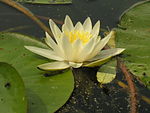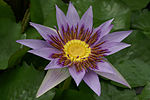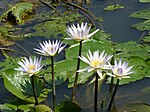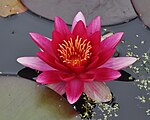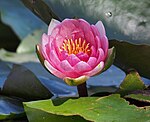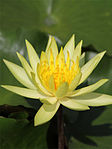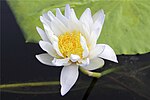Nymphaea
| Nymphaea | |
|---|---|

| |
| Nymphaea albaL., the type species of the genus[2] | |
| Scientific classification | |
| Kingdom: | Plantae |
| Clade: | Tracheophytes |
| Clade: | Angiosperms |
| Order: | Nymphaeales |
| Family: | Nymphaeaceae |
| Genus: | Nymphaea L. |
| Type species | |
| Nymphaea albaL.[2] | |
| Species | |
|
65 species, see text[1] | |
| Synonyms[1] | |
| |
Nymphaea(/nɪmˈfiːə/) is agenusofhardyand tenderaquatic plantsin the familyNymphaeaceae.The genus has acosmopolitan distribution.Many species are cultivated asornamental plants,and manycultivarshave been bred. Some taxa occur asintroduced specieswhere they are not native,[3]and some areweeds.[4]Plants of the genus are known commonly aswater lilies,[3][5]orwaterliliesin the United Kingdom. The genus name is from theGreekνυμφαία,nymphaiaand theLatinnymphaea,which mean "water lily" and were inspired by thenymphsofGreekandLatin mythology.[3]
Description[edit]
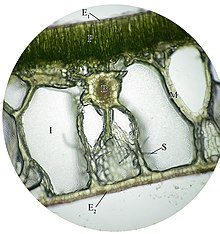
- E1: upper epiderm
- E2: lower epiderm
- P: palisade mesophyll
- M: spongy mesophyll
- B: vascular bundle
- I: intercellular gap
- S: sclerenchyma


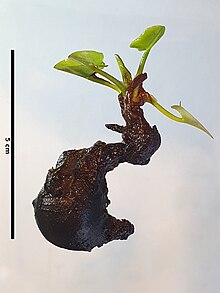


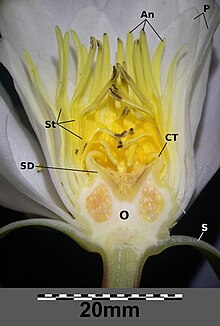
S= sepals,P= petals,St= stamina,An= anthers,O= ovary,SD= stigma disc,CT= carpellary teeth

Water lilies are aquaticrhizomatousherbaceousperennials,sometimes withstolonsas well. The stem is angular and erect. Theleavesgrow from the rhizome on longpetioles(stalk that attaches the leaf blade to the stem). Floating round leaves of waterlily grow up to 30 centimetres (12 inches) across. The disc-shaped leaf blades are notched and split to the stem in aV-shapeat the centre, and are often purple underneath. Most of them float on the surface of the water. The leaves have smooth or spine-toothed edges, and they can be rounded or pointed.
The flowers rise out of the water or float on the surface, opening during the day or at night.[3]Many species ofNymphaeadisplayprotogynousflowering. The temporal separation of these female and male phases is physically reinforced by flower opening and closing, so the first flower opening displays female pistil and then closes at the end of the female phase, and reopens with male stamens.[6]Each has at least eightpetalsin shades of white, pink, blue, or yellow. Manystamensare at the center.[3]Water lily flowers areentomophilous,meaning they arepollinatedby insects, oftenbeetles.[3]Thefruitis berry-like and borne on a curving or coilingpeduncle.[3] The plant reproduces by roottubersand seeds.
Taxonomy[edit]

This is one of several genera of plantsknown commonly as lotuses.It is not related to thelegumegenusLotusor the Asian and North American lotuses of genusNelumbo.It is closely related toNupharlotuses, however. InNymphaea,the petals are much larger than thesepals,whereas inNuphar,the petals are much smaller. The process of fruit maturation also differs, withNymphaeafruit sinking below the water level immediately after the flower closes, andNupharfruit remaining above the surface.[citation needed]
Subgenera[edit]
- Anecphya
- Brachyceras
- Confluentes
- Hydrocallis
- Lotos
- Nymphaea:
- sectionChamaenymphaea
- sectionNymphaea
- sectionXanthantha[7]
Species[edit]
As of January 2024, there are 65 accepted species byPlants of the World Online:[1]
- Nymphaea abhayanaA.Chowdhury & M.Chowdhury
- Nymphaea albaL.
- Nymphaea alexiiS.W.L.Jacobs & Hellq.
- Nymphaea amazonumMart. & Zucc.
- Nymphaea ampla(Salisb.) DC.
- Nymphaea atransS.W.L.Jacobs
- Nymphaea belophyllaTrickett
- Nymphaea×borealisE.G.Camus
- Nymphaea caatingaeC.T.Lima & Giul.
- Nymphaea candidaC.Presl
- Nymphaea carpentariaeS.W.L.Jacobs & Hellq.
- Nymphaea conardiiWiersema
- Nymphaea×daubenyanaW.T.Baxter ex Daubeny
- Nymphaea dimorphaI.M.Turner
- Nymphaea divaricataHutch.
- Nymphaea elegansHook.
- Nymphaea elleniaeS.W.L.Jacobs
- Nymphaea francaeC.T.Lima & Giul.
- Nymphaea gardnerianaPlanch.
- Nymphaea georginaeS.W.L.Jacobs & Hellq.
- Nymphaea giganteaHook.
- Nymphaea glanduliferaRodschied
- Nymphaea gracilisZucc.
- Nymphaea guineensisSchumach. & Thonn.
- Nymphaea harleyiC.T.Lima & Giul.
- Nymphaea hastifoliaDomin
- Nymphaea heudelotiiPlanch.
- Nymphaea immutabilisS.W.L.Jacobs
- Nymphaea jacobsiiHellq.
- Nymphaea jamesonianaPlanch.
- Nymphaea kakaduensisHellq., A.Leu & M.L.Moody
- Nymphaea kimberleyensis(S.W.L.Jacobs) S.W.L.Jacobs & Hellq.
- Nymphaea lasiophyllaMart. & Zucc.
- Nymphaea leibergii(Morong) Rydb.
- Nymphaea lingulataWiersema
- Nymphaea lorianaWiersema, Hellq. & Borsch
- Nymphaea lotusL.
- Nymphaea lukeiS.W.L.Jacobs & Hellq.
- Nymphaea macrospermaMerr. & L.M.Perry
- Nymphaea maculataSchumach. & Thonn.
- Nymphaea manipurensisAsharani & Biseshwori
- Nymphaea mexicanaZucc.
- Nymphaea micranthaGuill. & Perr.
- Nymphaea noelaeS.W.L.Jacobs & Hellq.
- Nymphaea nouchaliBurm.f.
- Nymphaea novogranatensisWiersema
- Nymphaea odorataAiton
- Nymphaea ondineaLöhne, Wiersema & Borsch
- Nymphaea oxypetalaPlanch.
- Nymphaea paganucciiC.T.Lima & Giul.
- Nymphaea pedersenii(Wiersema) C.T.Lima & Giul.
- Nymphaea potamophilaWiersema
- Nymphaea proliferaWiersema
- Nymphaea pubescensWilld.
- Nymphaea pulchellaDC.
- Nymphaea rapiniiC.T.Lima & Giul.
- Nymphaea rubraRoxb. ex Andrews
- Nymphaea rudgeanaG.Mey.
- Nymphaea siamensisPuripany.
- Nymphaea stuhlmannii(Engl.) Schweinf. & Gilg
- Nymphaea sulphureaGilg
- Nymphaea×sundvikiiHiitonen
- Nymphaea tenuinerviaCasp.
- Nymphaea tetragonaGeorgi
- Nymphaea thermarumEb.Fisch.
- Nymphaea×thionaD.B.Ward
- Nymphaea vanildaeC.T.Lima & Giul.
- Nymphaea vaporalisS.W.L.Jacobs & Hellq.
- Nymphaea violaceaLehm.
Fossil species[edit]
- †Nymphaea brongniartii(Caspary) Saporta[8]
Cultivation[edit]
Water lilies are not only decorative, but also provide useful shade which helps reduce the growth ofalgaein ponds and lakes.[9]Many of the water lilies familiar inwater gardeningarehybridsandcultivars.These cultivars have gained theRoyal Horticultural Society'sAward of Garden Merit:

- 'Escarboucle'[10](orange-red)
- 'Gladstoniana'[11](double white flowers with prominent yellow stamens)
- 'Gonnère'[12](double white scented flowers)
- 'James Brydon;'[13](cupped rose-red flowers)
- 'Marliacea Chromatella'[14](pale yellow flowers)
- 'Pygmaea Helvola'[15](miniature, with cupped fragrant yellow flowers)
Uses[edit]
This sectionneeds additional citations forverification.(June 2022) |
All water lilies are poisonous and contain analkaloidcallednupharinin almost all of their parts,[16]with the exception of the seeds and in some species, the tubers.
The European species contain large amounts of nupharin, and are considered inedible. The amount of nupharin in the leaves and stalks appears to vary seasonally in European species.
In some species, the rhizomes and tubers are eaten after boiling has neutralised the nupharin.
The tubers of a number of Australian, Asian and African species are completely edible, during thedry seasonsome consist almost entirely of starch.
TheAncient Egyptiansate them boiled.
In India, it has mostly been eaten as afamine foodor as a medicinal (both cooked),[17]but in one area the dried rhizomes were pounded into a sort of bread, and the tubers are often eaten in the floodplains.
InVietnam,the rhizomes were eaten roasted.
InSri Lankait was formerly eaten as a type of medicine and its price was too high to serve as a normal meal, but in the 1940s or earlier some villagers began to grow water lilies in thepaddy fieldsleft uncultivated during themonsoonseason (Yala season), and the price dropped. The tubers are calledmanelhere and eaten boiled and in curries.[17]
The tubers of all occurring species were eaten inWest AfricaandMadagascar(where they are calledtantamonfor blue andlaze-lazefor white), usually boiled or roasted.
In West Africa, usage varied between cultures, in the Upper Guinea the rhizomes were only considered famine foods - here the tubers were either roasted in ashes, or dried and ground into a flour. TheBuduma peopleate the seeds and rhizomes. Some tribes ate the rhizomes raw. TheHausa peopleof Ghana, Nigeria and the people of Southern Sudan used the tubers ofNymphaea lotus,the seeds (inside the tubers) are locally referred to as 'gunsi' in Ghana. They are ground into flour.[18]
In China the tubers were eaten cooked.
The plants were also said to be eaten in thePhilippines.In the 1950s there were no records of leaves or flowers being eaten.[19]
In a North American species, the boiled young leaves and unopened flower buds are said to be edible. The seeds, high in starch, protein, and oil, may be popped, parched, or ground into flour. Potato-like tubers can be collected from the speciesN. tuberosa(=N. odorata).[20]
The tubers ofNymphaea giganteaof Australia were roasted by certain tribes, these turn the colour blue when boiled, the tubers of other species were also roasted elsewhere on that continent.
Water lilies were said to have been a major food source for a certain tribe of indigenous Australians in 1930, with the flowers and stems eaten raw, while the "roots and seedpods" were cooked either on an open fire or in a ground oven.[21]
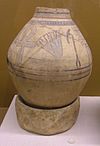
Culture[edit]



The Ancient Egyptians used the water lilies of theNileas cultural symbols.[22]Since 1580 it has become popular in the English language to apply the Latin wordlotus,originally used to designate a tree, to the water lilies growing in Egypt, and much later the word was used to translate words in Indian texts.[23]The lotus motif is a frequent feature of temple column architecture. In Egypt, the lotus, rising from the bottom mud to unfold its petals to the sun, suggested the glory of the sun's own emergence from theprimaeval slime.It was a metaphor of creation. It was a symbol of the fertility gods and goddesses as well as a symbol of the upper Nile as the giver of life.[22]
The flowers of the blue Egyptian water lily (N. caerulea) open in the morning and close at dusk, while those of thewhite water lily(N. lotus) open at night and close in the morning. Egyptians found this symbolic of the separation of deities and of death and the afterlife. Remains of both flowers have been found in the burial tomb ofRamesses II.[citation needed]
ARomanbeliefexisted that drinking a liquid of crushedNymphaeain vinegar for 10 consecutive days turned a boy into aeunuch.[24]
The Nymphaea, which is also called Nilufar in Persian, can be seen in many reliefs of the Achaemenid period (552 BC) such as the statue ofAnahitain thePersepolis.Lotus flower was included inKaveh the blacksmith'sDerafshand later as the flag of the Sasanian EmpireDerafsh Kaviani.Today, it is known as the symbol of IraniansSolar Hijri Calendar.[citation needed]
A Syrian terra-cotta plaque from the 14th–13th centuries BC shows the goddessAsherahholding two lotus blossoms. An ivory panel from the 9th-8th centuries BC shows the godHorusseated on a lotus blossom, flanked by twocherubs.[25]
There is a Polish poem by 19th-century poetJuliusz Słowackiin which the rhizomes are eaten.
TheFrenchImpressionistpainterClaude Monetis known forhis many paintings of water lilies in the pond in his gardenatGiverny.[26]
N. nouchaliis the national flower ofBangladesh[27]andSri Lanka.[28]
Water lilies are also used as ritual narcotics. According to one source, this topic "was the subject of a lecture by William Emboden given at Nash Hall of theHarvard Botanical Museumon the morning of April 6, 1979 ".[29]
Examples[edit]
-
Nymphaea'Attraction'
-
Nymphaea"Laydekeri Purpurata"
-
Nymphaeasp.
See also[edit]
- Albert de Lestang,propagator and seed collector
- List of plants known as lily
References[edit]
- ^abc"NymphaeaL. "Plants of the World Online.Royal Botanic Gardens, Kew.Retrieved9 January2024.
- ^abNymphaea| International Plant Names Index. (n.d.). Retrieved June 26, 2023, fromhttps://www.ipni.org/n/330032-2
- ^abcdefgNymphaea.Flora of North America.
- ^Nymphaea.The Jepson eFlora 2013.
- ^Nymphaea.Integrated Taxonomic Information System (ITIS).
- ^Povilus, R. A.; Losada, J. M.; Friedman, W. E. (2015)."Floral biology and ovule and seed ontogeny ofNymphaea thermarum,a water lily at the brink of extinction with potential as a model system for basal angiosperms ".Annals of Botany.115(2): 211–226.doi:10.1093/aob/mcu235.PMC4551091.PMID25497514.
- ^"USDA GRIN Taxonomy.NymphaeaL. "
- ^Butzmann, R., & Fischer, T. C. (2013)."Fossil water lily fruits with seedsNymphaeasubgenusLotos,from the Oligocene of Armissan/Narbonne (France). "Zitteliana, 93-104.
- ^RHS A-Z Encyclopedia of Garden Plants.United Kingdom: Dorling Kindersley. 2008. p. 1136.ISBN978-1405332965.
- ^"RHS Plant Selector -Nymphaea'Escarboucle'".Retrieved16 January2021.
- ^"RHS Plant Selector -Nymphaea'Gladstoniana'".Retrieved16 January2021.
- ^"RHS Plant Selector -Nymphaea'Gonnere'".Retrieved16 January2021.
- ^"RHS Plant Selector -Nymphaea'James Brydon'".Retrieved16 January2021.
- ^"RHS Plant Selector -Nymphaea'Marliacea Chromatella'".Retrieved16 January2021.
- ^"RHS Plant Selector -Nymphaea'Pygmaea Helvola'".Retrieved16 January2021.
- ^Chapter 10NupharAlkaloids. J.T. Wróbel, The Alkaloids: Chemistry and Physiology, 1967, Volume 9, Pages 441–465,doi:10.1016/S1876-0813(08)60206-7
- ^abTiwari, Ashok (September 2019). "Nutritional composition and antioxidative stress properties in boiled tuberous rhizome of Neel Kamal (Nymphaea nouchaliBurm. f.) ".Indian Journal of Natural Products and Resources.10(1): 59–67.
- ^Adanse, John; Bigson, Kate; Dare, Nyefene Joe; Glago, Patricia (2021). "Proximate and Functional Properties of Water Lily (Nymphaea Lotus),Coconut (Cocos Nicifera) and Wheat (Titricum Aestivum) Flour Blends ".J Food Tech Food Chem.3:104.
- ^FR Irvine, RS Trickett -Water lilies as Food- Kew Bulletin, 1953
- ^Peterson, L. A. (1977).A Field Guide to the Wild Edible Plants of Eastern and Central North America.New York, New York: Houghton Mifflin. p. 22.
- ^McConnel, U. H. 1930. ‘The Wik-Munkan Tribe of Cape York Peninsula’. Oceania 1: 97–108
- ^abTresidder, Jack (1997).The Hutchinson Dictionary of Symbols.London: Duncan Baird Publishers. p. 126.ISBN1-85986-059-1.
- ^Harper, Douglas."The Origin and Meaning of the word 'Lotus'".Etymology Online.Douglas Harper.Retrieved1 April2021.
- ^Marcellus Empiricus,De medicamentis33.64; comparePliny the Elder,Natural History25.75 (37). "There is an herb callednymphaeain Greek, 'Hercules’ club' in Latin, andbaditisin Gaulish. Its root, pounded to a paste and drunk in vinegar for ten consecutive days, has the astonishing effect of turning a boy into a eunuch. "
- ^Dever, W. G.Did God have a Wife? Archeology and Folk Religion in Ancient Israel.Wm. B. Eerdmans Publishing Co. 2008. pp 221, 279.
- ^"Water Lilies: Claude Monet (French, 1840–1926)".Heilbrunn Timeline of Art History.Metropolitan Museum of Art. December 2008.Retrieved8 March2015.
- ^"Bangladesh Constitution. Part I, The Republic, 4(3)".Archived fromthe originalon 2013-10-29.Retrieved2013-06-22.
- ^Jayasuriya, M.Our national flower may soon be a thing of the past.The Sunday TimesApril 17, 2011.
- ^"The Ethnopharmacology Society Newsletter". Vol. 2, no. 4. Spring 1979.
External links[edit]
Further reading[edit]
- Slocum, P. D.Waterlilies and Lotuses.Timber Press. 2005.ISBN0-88192-684-1(restricted online version at Google Books)

